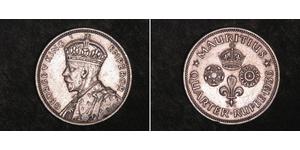1 Rupee British Empire (1497 - 1949) Silver
1888, Mombasa (today´s Zanzibar). Silver Rupee Coin. Birmingham mint!
Mint Year: 1888 References: KM-5. Mintage: 94,000 pcs. Denomination: Silver Rupee Mint Place: Heaton´s Mint (Birmingham) Condition: Scratches, minor deposits, othewrise about XF! State: Mombasa (for the Imperial British East Africa Company) Material: Silver (.917) Weight: 11.55gm Diameter: 30mm
Obverse: Crown above radiant sun and inscribed banner. Legend: ONE RUPEE . MOMBASA . LIGHT AND LIBERTY Reverse: Scale above arabic characters and date. Legend: IMPERIAL BRITISH EAST AFRICA COMPANY : 1888 H .
The Imperial British East Africa Company (IBEAC) was the administrator of British East Africa, which was the forerunner of the East Africa Protectorate, later Kenya. The IBEAC was a commercial association founded to develop African trade in the areas controlled by the British colonial power. Created after the Berlin Treaty of 1885, it was led by William Mackinnon and built upon his company’s trading activities in the region, with the encouragement of the British government. Mombasa and its harbour were central to its operations, with an administrative office about 80 km south in Shimoni. The company was incorporated in London on 18 April 1888, and granted a royal charter by Queen Victoria on 6 September 1888.
The IBEAC oversaw an area of approximately 246,800 mi² (639,209 km²) situated along the eastern coast of Africa, its centre being at about 39° East longitude and 0° latitude, and from 1890 also administered Uganda. The administration of British East Africa was transferred to the Foreign Office on 1 July 1895, and in 1896 so was control of Uganda.
In the early 1880s, European powers began rushing to obtain unclaimed territories within areas of interest in Africa. One of these areas, the Sultanate of Zanzibar and the interior of Eastern Africa, caught the attention of both Germany and Britain. Hoping to resolve this common interest in a peaceful manner, in 1886, Germany and Britain signed a treaty in which they agreed upon what lands they would exclusively pursue. Germany would lay claim to the coast of present day Tanzania and Britain retained access to the area in which Kenya and Uganda lie.
At this same time, Britain was focusing its resources in other interests which included land acquired in Southern Africa. This left the British Rule reluctant in accepting full responsibility for this newly acknowledged region. In an effort to ease this potential burden, Britain considered allowing a commercial company the right to administer and develop the eastern territory. In 1888, Sir William Mackinnon and the Imperial British East Africa Company (IBEAC) were authorized to serve this very purpose.
The IBEAC assumed responsibility for land stretching from the eastern coast of Africa to Uganda all the way to the northwestern shore of Lake Victoria.
Other than the expected work involved with governing the exportation and management of goods and agriculture, the main role of the IBEAC was to begin facilitating the construction of a railway connecting the east coast region of Mombasa to Lake Victoria. The IBEAC started building the Mackinnon-Sclater road, a 600-mile/1000 km ox cart track from Mombasa to Busia on the Uganda border, in 1890.
Unfortunately brewing conflict between rival factions ultimately prevented the company from investing the necessary time and money into this venture. The four groups involved in Uganda, the Kabaka, French Catholics, Protestants, and the Company, could not resolve their squabble amicably and with tensions continuing to rise, civil war broke out in January 1892. With the aid of Frederick Lugard, the individual given the task of building the Company a fortified location, the IBEAC earned itself a fruitless victory.
This conflict proved to be the company’s final undoing. IBEAC was already struggling financially due to customs issues but the money spent funding this skirmish all but bankrupted it. This also made clear that the company would be unable to continue its poorly executed attempt at colonizing eastern Africa.
The British East Africa Company proved to be an ineffective attempt at allowing commercial businesses local administrative rights. Inevitably, in 1894, the British government declared a protectorate over Uganda effectively dissolving IBEAC and assuming full responsibility.
The main part of the Mackinnon-Sclater road was completed by the British government after the demise of the IBEAC. The British government eventually built the Uganda Railway to Kisumu, at Lake Victoria, between 1896 and 1901.
| 1 | 2 |
|---|
(740 X 368pixels, file size: ~63K)
Posted by: anonymous 2020-11-15
1888,Kenia-Mombasa. Imperial British East Africa Company 1887-1895. Rupie 1888 H. K.M. 5. Schöne Patina. Kleine Kratzer, sehr schön +.
(740 X 369pixels, file size: ~53K)
Posted by: anonymous 2020-11-12
1888,Kenia-Mombasa. Imperial British East Africa Company 1887-1895. Rupie 1888 H. K.M. 5. Schöne Patina. Vorzüglich.
(740 X 368pixels, file size: ~58K)
Posted by: anonymous 2019-09-24
1888,Kenia-Mombasa. Imperial British East Africa Company 1887-1895. Rupie 1888 H. K.M. 5. Winzige Kratzer, vorzüglich
(1537 X 740pixels, file size: ~270K)
Posted by: anonymous 2019-06-14
1888, Mombasa (today´s Zanzibar). Beautiful Silver Rupee Coin. Birmingham mint! Mint Year: 1888 References: KM-5. Mintage: 94,000 pcs. Denomination: Silver Rupee Mint Place: Heaton´s Mint (Birmingham) Condition: Scratches, minor deposits, othewrise about XF! State: Mombasa (for the ...
(1500 X 747pixels, file size: ~206K)
Posted by: anonymous 2019-05-08
Kenia-Mombasa. Imperial British East Africa Company 1887-1895. Rupie 1888 H. K.M. 5. Winzige Kratzer, vorzüglich
(1500 X 748pixels, file size: ~211K)
Posted by: anonymous 2019-05-08
Kenia-Mombasa. Imperial British East Africa Company 1887-1895. Rupie 1888 H. K.M. 5. Polierte Platte. Einige kleine Kratzer, vorzüglich +
1.5 Penny United Kingdom Silver Victoria (1819 - 1901)
group has 5 coins / 5 prices
⇑
1 Thaler Holy Roman Empire (962-1806) Silver Ferdinand Charl ...
group has 2 coins
⇑

-500-250-qGsKX9ISubMAAAFaDA5MgKnU.jpg)
-300-150-uBV_dbXUFWYAAAF1ql3iU818.jpg)
-300-150-eaJ_dbXUNeYAAAF16tviU7pC.jpg)
-300-150-aZu9Ude9rvUAAAFtmyZLIWFQ.jpg)
-300-150-nmsbmpJTmXMAAAFrYmchf1SU.jpg)
-300-150-FWt0WDeK_1UAAAFqK0eVQJXx.jpg)
-300-150-vSt0WDeKk_YAAAFq8w6VQJXx.jpg)








-300-150-E0EKbzbiuaQAAAFGGYXW.Z4s.jpg)






